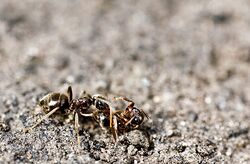Biology:Necrophoresis

Necrophoresis is a sanitation behavior found in social insects – such as ants, bees, wasps, and termites – in which they carry away the dead bodies of members of their colony from the nest or hive area. The term was introduced in 1958 by E.O. Wilson and his colleagues.[1] The behaviour was however known from before with Pliny making the claim that ants were the only animals other than humans to bury their dead.[2]
Description
While the strict definition of necrophoresis deals with the removal of dead nestmates only,[3] others have extended it to the removal of corpses that include non-nestmates and even alien species. The adaptive value of the behavior is that it acts as a sanitary measure to prevent disease or infection from spreading throughout the colony.[4][5]
Castes and specialization
Although any member of a colony can carry the bodies, it is usually done by designated 'undertakers'. Ant undertakers have a slightly altered development cycle, and are much more likely than other ants to handle corpse removal. They are not restricted to performing only this task, but they do exhibit different behavioral and movement patterns than other members of the colony, which assist them in this task.[6] Non-undertaker ants may also remove dead bodies, but do so with much less consistency.[7] Corpses will either be taken to a random point a certain distance away from the nest, or placed in a refuse pile closer to the nest, along with other waste. Although in mature ant colonies only workers feature undertaking behaviours, the queen ants from the Lasius niger species undertake deceased co-founders.[8]
The removal of corpses carrying infectious disease is crucial to the health of a colony. Efforts to eliminate colonies of fire ants, for instance, include introducing pathogens into the population, but this has limited efficacy where the infected insects are quickly separated from the population. However, certain infections have been shown to delay the removal of dead bodies or alter where they are placed.[9] Although placing corpses farther away reduces the risk of infection, it also requires more energy. Burial and cannibalism are other recorded methods of corpse disposal among social insects. Termites have been shown to use burial when they cannot afford to devote workers to necrophoresis, especially when forming a new colony.[10]
Identification of disease and death
Differentiating between dead and living insects is accomplished by detecting their chemical signature. Depending on the species, this can be communicated by either the absence of chemicals that are present when they are alive,[11] or by those released in decaying corpses. Experiment have sought to identify how ants identify corpses that need to be disposed and have found that in some cases it is the presence of oleic and linoleic acid, produced by the breakdown of fats. This breakdown can take about two days. There are also differences in how dead nestmates and non-nestmates are treated.[12][13] Seed collection and dispersal behaviors in myrmecochory are also found to be similar to those involved in necrophory and triggered by similar chemicals.[14][failed verification][clarification needed]
References
- ↑ Wilson, E.O.; Durlach, N.I.; Roth, L.M. (December 1958). "Chemical Releasers of Necrophoric Behavior in Ants" (in en). Psyche: A Journal of Entomology 65 (4): 108–114. doi:10.1155/1958/69391. ISSN 0033-2615. https://www.researchgate.net/publication/27372482.
- ↑ The Natural History of Pliny. 3. London: Henry G. Bohn. 1855. p. 38. https://archive.org/details/naturalhistoryof03plin/page/n59/mode/2up.
- ↑ López-Riquelme, Germán Octavio; Fanjul-Moles, María Luisa (2013). "The Funeral Ways of Social Insects. Social Strategies for Corpse Disposal". Trends in Entomology 9: 71–129. https://www.researchgate.net/publication/260715254.
- ↑ Diez, Lise; Lejeune, Philippe; Detrain, Claire (July 2014). "Keep the nest clean: survival advantages of corpse removal in ants". Biology Letters 10 (7). doi:10.1098/rsbl.2014.0306. PMID 25009241.
- ↑ Sun, Qian; Zhou, Xuguo "Joe" (March 2013). "Corpse Management in Social Insects". International Journal of Biological Sciences 9 (3): 313–321. doi:10.7150/ijbs.5781. https://www.ijbs.com/v09p0313.pdf. Review
- ↑ Trumbo, Stephen T.; Huang, Zhi-Yong; Robinson, Gene E. (September 1997). "Division of Labor Between Undertaker Specialists and Other Middle-aged Workers in Honey Bee Colonies". Behavioral Ecology and Sociobiology 41 (3): 151–163. doi:10.1007/s002650050374.
- ↑ López-Riquelme, Germán Octavio; Malo, Edi A.; Cruz-López, Leopoldo; Fanjul-Moles, María Luiza (November 2006). "Antennal olfactory sensitivity in response to task-related odours of three castes of the ant Atta mexicana (hymenoptera: formicidae)". Physiological Entomology 31 (4): 353–360. doi:10.1111/j.1365-3032.2006.00526.x.
- ↑ Pull, Christopher D.; Cremer, Sylvia (13 October 2017). "Co-founding ant queens prevent disease by performing prophylactic undertaking behaviour". BMC Evolutionary Biology 17 (1): 219. doi:10.1186/s12862-017-1062-4. PMID 29025392.
- ↑ Fan, Yanhua, Pereira, Roberto M., Kilic, Engin, CAsella, George, Keyhani, Nemat O., "Pyrokinin b-Neuropeptide Affects Necrophoretic Behavior in Fire Ants (S. invicta), and Expression of b-NP in a Mycoinsecticide Increases Its Virulence" PLoS ONE, Vol. 7 Issue 1, January 2012
- ↑ Chouvenc, Thomas; Robert, Alain; Sémon, Etienne; Bordereau, Christian (February 2012). "Burial behavior by dealates of the termite Pseudacanthotermes spiniger (Termitidae, Macrotermitinae) induced by chemical signals from termite corpses". Insectes Sociaux (International Union for the Study of Social Insects (IUSSI)) 59 (1): 119–125. doi:10.1007/s00040-011-0197-3. https://www.researchgate.net/publication/225366314.
- ↑ Choe, Dong-Hwan, Millar, Jocelyn G., Rust, Michael K., Hildebrand, John G., "Chemical Signals Associated with Life Inhibit Necrophoresis in Aegentine Ants", Proceedings of the National Academy of Sciences of the United States of America, Vol. 106 No. 20 (May 10, 2009), pp. 8251-8255.
- ↑ Diez, Lise; Moquet, Laura; Detrain, Claire (2013). "Post-mortem Changes in Chemical Profile and their Influence on Corpse Removal in Ants" (in en). Journal of Chemical Ecology 39 (11–12): 1424–1432. doi:10.1007/s10886-013-0365-1. ISSN 0098-0331. PMID 24242873. http://link.springer.com/10.1007/s10886-013-0365-1.
- ↑ Zelagin, David M.; Hund, Amanda K.; Breed, Michael D. (2018). "Spatial Aspects of Corpse Removal in the Western Harvester Ant, Pogonomyrmex occidentalis" (in en). Journal of Insect Behavior 31 (3): 241–254. doi:10.1007/s10905-018-9675-z. ISSN 0892-7553. http://link.springer.com/10.1007/s10905-018-9675-z.
- ↑ Detrain, Claire; Bologna, Audrey (June 2019). "Impact of seed abundance on seed processing and dispersal by the red ant Myrmica rubra" (in en). Ecological Entomology 44 (3): 380–388. doi:10.1111/een.12713. https://onlinelibrary.wiley.com/doi/10.1111/een.12713. Manuscript from ScholarOne
 |

